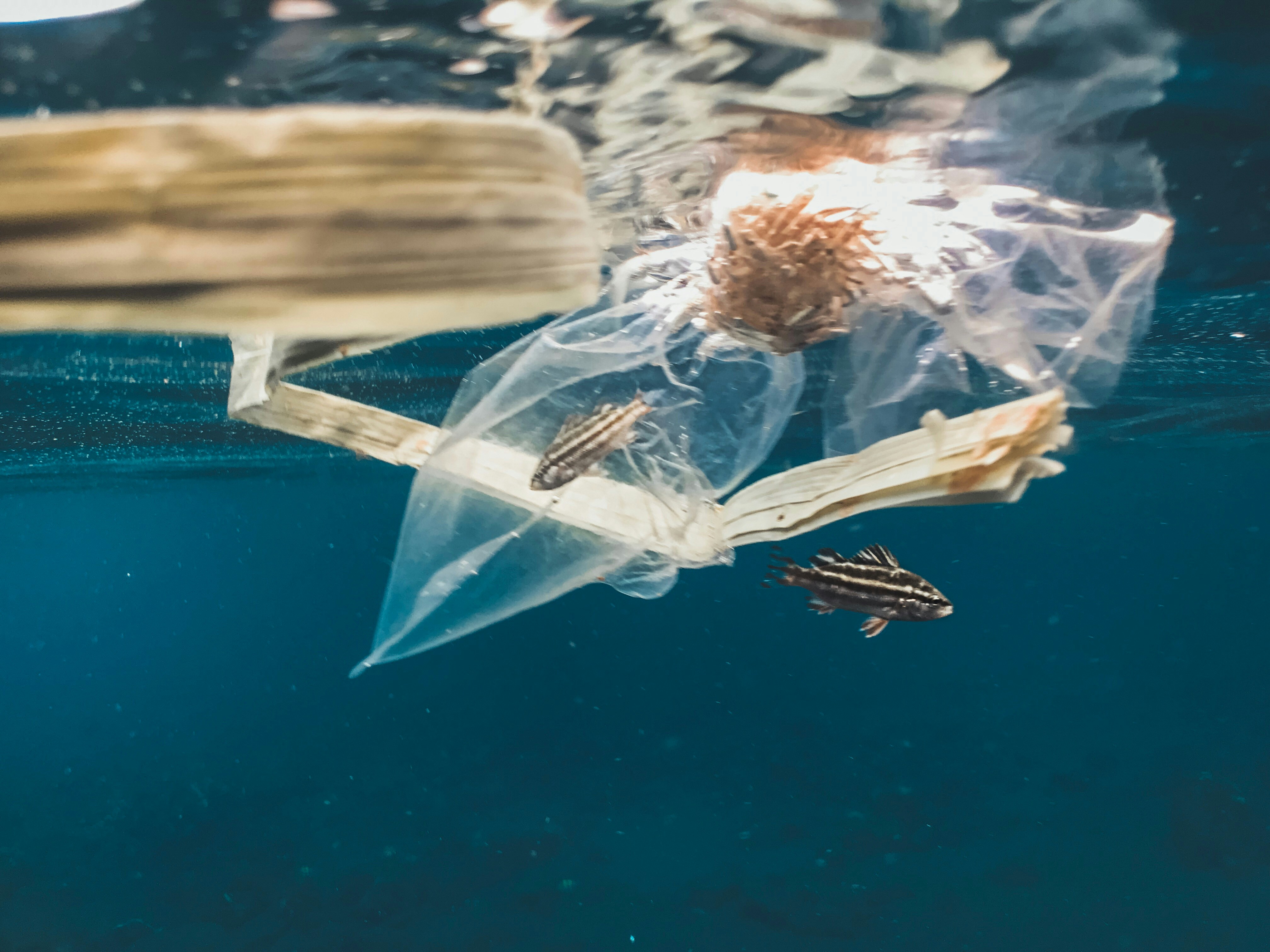Introduction to Microplastics
Microplastics are tiny plastic particles that measure less than five millimeters in diameter. They can originate from a variety of sources, including the fragmentation of larger plastic debris, such as bottles and bags, or through industrial processes that create plastic pellets. Additionally, microplastics are commonly found in personal care products, such as exfoliating scrubs and certain types of toothpaste, as well as synthetic fibers that shed from clothing during washing.
Everyday products often contain microplastics, making them an unavoidable element of modern life. Their presence extends beyond consumer goods; microplastics have been detected in freshwater systems, oceans, and even the air we breathe. This widespread prevalence raises significant environmental concerns, as these persistent pollutants can adversely affect ecosystems and wildlife. Marine organisms, for instance, can ingest microplastics, leading to potential bioaccumulation and impacting the food chain.
As microplastics enter the human body primarily through dietary consumption and inhalation, researchers have begun to explore the potential health ramifications of such exposure. Food sources, particularly seafood, have been shown to contain microplastic particles, prompting investigations into their implications on human health. While the full extent of potential health risks remains unclear, existing studies suggest that microplastics may accumulate in various organs and tissues, leading to inflammatory responses or other adverse health effects.
Thus, understanding microplastics and their sources is pivotal as we seek to address the environmental and health concerns linked to their presence. The accumulation of evidence indicates an urgent need for public awareness and proactive approaches to mitigate microplastic pollution, given its growing impact on both ecological systems and human health.
The Science of Microplastics in the Human Body
Recent studies have increasingly focused on the presence of microplastics within the human body, revealing disturbing implications for health and physiology. Microplastics, defined as plastic particles smaller than 5mm, can enter the human body through various pathways, including ingestion, inhalation, and dermal exposure. Research has identified microplastics in diverse human tissues and fluids, such as blood, liver, and even breast milk, which raises significant concerns regarding their potential effects on human health.
A prominent study published in the journal “Environmental Science & Technology” in 2021 showcased the detection of microplastics in human blood for the first time, confirming their ability to circulate within the body. This detection sparked further research into how microplastics could contribute to various health problems, including inflammation, immune system interference, and disruptions in hormonal balances. Moreover, other studies have noted the accumulation of these foreign particles in organs, suggesting potential long-term health risks associated with chronic exposure.
The physiological effects of microplastics are still being thoroughly investigated, but preliminary evidence implies they may induce oxidative stress, alter metabolic processes, and even lead to cellular apoptosis. Furthermore, some research posits that microplastics can serve as vectors for harmful chemicals and pathogens, compounding their detrimental impacts. Given the pervasive presence of microplastics in the environment and their entry into our bodies, understanding their biological consequences is imperative for public health.
As the scientific community continues to explore the relationship between microplastics and health outcomes, it remains essential for individuals to be aware of their potential sources and consider strategies to minimize exposure. Ongoing research will be crucial in establishing definitive connections between microplastics and specific health issues, ultimately guiding future public health policies and preventative measures.
Understanding Detoxification: The Body’s Natural Processes
The human body is equipped with an intricate network of organs and systems designed to remove toxins and maintain homeostasis. The primary organs involved in detoxification include the liver, kidneys, and digestive system. Each of these systems plays a critical role in filtering and eliminating harmful substances that may accumulate from various sources, including food, environmental exposures, and metabolic processes.
The liver is often regarded as the body’s main detoxifying organ. It processes blood and metabolizes various chemicals, converting fat-soluble toxins into water-soluble compounds that can be excreted via urine or bile. This transformation is facilitated by a series of enzymatic reactions, including phase I (oxidation, reduction, hydrolysis) and phase II (conjugation) metabolic processes. By performing these functions, the liver not only detoxifies but also helps regulate vital biochemical pathways essential for survival.
The kidneys also play a significant role in detoxification by filtering blood to remove waste products and excess substances. Through the process of urine formation, they maintain electrolyte balance and aid in the elimination of both organic and inorganic toxins. Efficient kidney function is crucial, as any impairment in this system can lead to a buildup of harmful substances in the body.
The digestive system contributes to detoxification by processing the food we consume and breaking down toxins before they enter the bloodstream. Fiber-rich foods not only support regular bowel movements but also promote the elimination of potential contaminants from the gastrointestinal tract. However, certain substances, like microplastics, pose unique challenges to these natural processes. They can accumulate in the body due to their small size and persistence, raising questions about the efficacy of traditional detoxification methods in addressing these specific pollutants.
Understanding the body’s detoxification mechanisms is essential when considering how these processes apply to the removal of microplastics. The limitations inherent in the detoxification of such contaminants call for further investigation into safe and effective methods for minimizing their impact on human health.
Can You Actually Detox from Microplastics?
As the conversation around microplastics increasingly gains attention, a pertinent question arises: can individuals effectively detox from these ubiquitous particles? Microplastics are small plastic fragments, typically measuring less than five millimeters, that arise from various sources such as the breakdown of larger plastic debris and the shedding of synthetic fibers from clothing. Recent scientific investigations into the presence and accumulation of microplastics in the human body have accelerated curiosity regarding their potential removal or detoxification.
Current research indicates that while microplastics can enter the human body through ingestion, inhalation, and dermal contact, the full extent of their metabolism or elimination is still not entirely understood. Preliminary studies suggest that the human body may not be adept at metabolizing these particles due to their resistant nature. Instead, microplastics might accumulate in various organs and tissues, thus raising significant health concerns. Some findings imply that smaller microplastic particles could be cleared more easily through bodily functions such as excretion, while larger particles pose a greater challenge in terms of removal.
Despite these insights, the science surrounding the detoxification of microplastics remains in its infancy. Researchers are actively examining various detoxification methods, such as dietary interventions or the use of specific supplements that might aid in the expulsion of these substances. However, there is currently insufficient evidence to validate the effectiveness of these approaches. The potential for bioaccumulation and long-term health implications of microplastics remains a pressing area for future research.
In essence, while the possibility of detoxifying from microplastics is a topic of growing interest, more comprehensive and conclusive studies are necessary to provide definitive answers. As our understanding evolves, so too does the strategy for addressing microplastics in our environment and bodies.
Current Detoxification Methods: Do They Work?
The rising concern regarding the presence of microplastics in the environment has prompted individuals to seek various detoxification methods to eliminate these substances from their bodies. Among these methods, dietary changes, dietary supplements, and lifestyle modifications are frequently touted as effective strategies to remove environmental toxins, including microplastics. However, the scientific evidence surrounding the efficacy of these detox practices is still evolving.
Dietary changes are commonly recommended as a primary detoxification strategy. Advocates suggest that consuming a diet rich in antioxidants, fiber, and whole foods can help mitigate the effects of toxic substances. For example, foods such as dark leafy greens, berries, and nuts are thought to support the body’s detoxification pathways. However, while a healthy diet can enhance overall well-being and may improve the body’s ability to process various contaminants, there is limited direct evidence linking specific dietary changes to the elimination of microplastics.
Another popular strategy involves the use of dietary supplements, such as activated charcoal or certain herbal extracts, which are believed to bind toxins and facilitate their excretion. However, current research has not definitively demonstrated that these supplements are effective at removing microplastics specifically from the human body. The gastrointestinal absorption and bioavailability of microplastics remain an area of ongoing study, making it challenging to validate the efficacy of such supplements.
Lifestyle modifications, which may include stress management techniques, increased hydration, and regular physical activity, are also often suggested as methods to enhance detoxification. While these practices can contribute to better health and may improve the body’s natural detoxification processes, similar to dietary changes, conclusive evidence regarding their impact on microplastics detoxification is currently lacking.
Overall, while various detoxification methods are popular among those concerned about microplastics, rigorous scientific validation of their effectiveness is still needed. The complex nature of microplastic absorption and retention in the body necessitates further research to provide conclusive answers regarding detoxification methods.
Enhancing the Body’s Natural Detoxification
Supporting the body’s innate detoxification processes is crucial, especially considering the rising concerns regarding environmental contaminants such as microplastics. There are several actionable steps individuals can take to enhance these natural detoxification mechanisms, focusing on diet, hydration, exercise, and holistic approaches.
To begin with, a well-balanced diet rich in antioxidants can significantly aid the detoxification process. Foods high in antioxidants, such as berries, leafy greens, nuts, and seeds, help neutralize free radicals and facilitate the elimination of various toxins, including microplastics. Incorporating fiber-rich foods like whole grains, legumes, and vegetables into one’s diet is equally important, as fiber bolsters gut health and promotes regular bowel movements, which are essential for removing waste products from the body.
Hydration is another key factor in promoting detoxification. Drinking adequate amounts of water throughout the day helps to flush out toxins, including microplastics, while also supporting kidney function. Herbal teas, such as dandelion or green tea, can further assist in detoxification due to their diuretic properties and high antioxidant content. It is recommended to limit the intake of sugary beverages and alcohol, as they can impede the body’s natural detoxification abilities.
Regular physical exercise plays a pivotal role in enhancing the body’s detoxification processes. Activities such as aerobic exercises, strength training, and yoga can stimulate circulation and lymphatic flow, promoting the expulsion of toxins through sweat and improved metabolic function. Engaging in activities that encourage deep breathing, such as yoga or meditation, can also support relaxation and mental clarity, further contributing to overall well-being.
Lastly, adopting holistic approaches such as mindfulness practices and reducing exposure to environmental toxins can create a comprehensive detoxification strategy. Mindfulness can help individuals to make conscious food and lifestyle choices, while taking measures to limit contact with plastic products is essential in minimizing microplastic intake. By implementing these strategies, individuals can empower their bodies to effectively address environmental challenges, including those posed by microplastics.
Preventing Microplastic Exposure
As awareness of microplastics and their potential health effects has grown, it is crucial for individuals to adopt practical measures to reduce their exposure. One of the most effective strategies is to consciously choose safer products, particularly in everyday items such as personal care and household products. Opting for products made from natural materials can significantly decrease the risk of microplastic ingestion. For instance, selecting biodegradable personal care items—like natural exfoliants instead of plastic beads—can effectively mitigate exposure levels.
Furthermore, paying attention to food packaging is essential. Individuals can minimize contact with microplastics by opting for fresh produce and bulk items rather than packaged goods, as the latter often contain microplastic contaminants. Utilizing glass or stainless-steel containers instead of plastic for food storage also presents a viable solution. This simple change not only aids in reducing microplastic consumption but also benefits overall health by eliminating harmful chemicals derived from plastic materials.
Another critical factor to consider is water filtration. Microplastics have been detected in tap water, making it advisable to use home water filters certified to remove such contaminants. Investing in a good filtration system can be a proactive approach to ensuring the purity of drinking water, significantly lowering microplastic levels that may otherwise enter the body through hydration.
Finally, advocating for cleaner environments is vital in the broader fight against microplastics. Supporting policies geared towards reducing plastic production and enhancing waste management can lead to less plastic pollution overall. Participating in local cleanup activities and promoting awareness about the impacts of microplastics can inspire others to take action, creating a healthier planet and, consequently, a healthier society.
The Importance of Research and Policy Changes
The issue of microplastics, particles resulting from the degradation of larger plastic items, has become a focal point of environmental health discussions in recent years. Although significant strides have been made in identifying their prevalence in ecosystems, there remains a substantial gap in research concerning their long-term health effects on humans. Understanding these impacts is critical, as microplastics can infiltrate food and water supplies, which may contribute to various health issues. Ongoing studies are essential to establish a clear link between microplastics exposure and any potential health repercussions.
Moreover, current regulations surrounding the use of plastics do not adequately address the risks associated with microplastics. Policymakers must recognize the need for comprehensive frameworks that regulate plastic production and encourage alternatives to single-use plastics. This could include incentives for research into biodegradable materials or strategies to promote recycling programs. By prioritizing stricter regulations on plastic manufacturing and waste management, governance can play a pivotal role in reducing the entry of microplastics into ecosystems.
Another critical aspect of tackling microplastic pollution involves enhancing public awareness and advocacy. Many individuals are unaware of the sources and implications of microplastic contamination, making education vital. Public campaigns can inform citizens about responsible consumption, proper waste disposal, and the significance of supporting brands committed to sustainability. Furthermore, collaborative initiatives between researchers, environmental organizations, and government bodies can foster a more focused approach to addressing the microplastics crisis.
In conclusion, the urgency of ongoing research into microplastics, coupled with significant policy changes, is fundamental in mitigating this environmental issue. Understanding their health effects and establishing robust regulations could pave the way for a healthier future, not only for humans but also for the ecosystems we inhabit.
Conclusion: Moving Forward in the Fight Against Microplastics
As we draw our discussion to a close regarding the potential for detoxing from microplastics, it becomes clear that this is not merely a health concern but a significant broader environmental issue. Microplastics are pervasive and have permeated various aspects of our lives, affecting ecosystems and human health alike. While current research suggests limited capability for complete detoxification from microplastics once they enter the body, it is imperative to recognize the proactive steps individuals can undertake to mitigate their exposure.
Individual actions, such as reducing reliance on plastic products, opting for natural fibers in clothing, and supporting policies aimed at decreasing plastic waste, play a pivotal role. While personal efforts are essential, the responsibility does not rest solely on individuals; collective action is vital. Communities, businesses, and governments must collaborate to implement effective measures, promote sustainable practices, and invest in research and technology aimed at tackling plastic pollution. Public awareness is also crucial; educating ourselves and others about the impact of microplastics can galvanize community efforts towards meaningful change.
In addressing this challenge, it is important to remain informed about the latest findings in scientific research. Innovations continue to emerge, offering potential solutions for not only detoxification but also innovative ways to prevent the introduction of microplastics into our environments. As we move forward, a balanced approach that combines individual responsibility with systemic change is necessary for a comprehensive response to the microplastic crisis. By fostering a culture of sustainability, supporting ecological preservation, and actively participating in reduction initiatives, we can make strides in overcoming the challenges posed by microplastics and protecting both our health and the planet.






